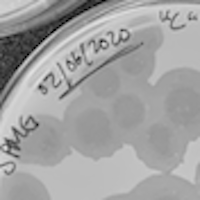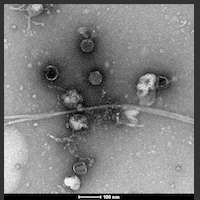Microbacterium phage Nigiri
Know something about this phage that we don't? Modify its data.
| Detailed Information for Phage Nigiri | |
| Discovery Information | |
| Isolation Host | Microbacterium foliorum NRRL B-24224 |
| Found By | Sarah Perez |
| Year Found | 2020 |
| Location Found | Spokane, WA United States |
| Finding Institution | Gonzaga University |
| Program | Science Education Alliance-Phage Hunters Advancing Genomics and Evolutionary Science |
| From enriched soil sample? | Yes |
| Isolation Temperature | 23°C |
| GPS Coordinates | 47.999722 N, 117.683056 W Map |
| Discovery Notes | Soil was a little looser and had contents of grass and other natural debris aside from just soil. When mixed, the color was very dark probably because the soil was richer being that it was collected near the river my Jepsen. This soil sample was right near a big water source where snow had to be dug up in order for the sample to be collected after hacking at the frozen ground. |
| Naming Notes | The phage was named after the fact that I really love sushi- thus naming my phage "Nigiri"- since Nigiri is my favorite type of sushi. |
| Sequencing Information | |
| Sequencing Complete? | No |
| Genome length (bp) | Unknown |
| Character of genome ends | Unknown |
| Fasta file available? | No |
| Characterization | |
| Cluster | Unclustered |
| Subcluster | -- |
| Annotating Institution | Unknown or unassigned |
| Annotation Status | Not sequenced |
| Plaque Notes | when analyzing the phage morphology, the clearings were typically in the shape of a perfect circle where the distance from the center is even all around. During the first sample collection, its diameter is about 1.6cm. They all had the same circular patter, shape, and size all throughout the spread of the dish. There are several massive patches of phage clearings where the results are. It's very easy to see the size, configuration, and shape of the phage clearings because there are patches of lawn and top agar that still surround them. The phage clearings are big, splotchy patches that group together and blend into one another. They form into one another and eat into each other. They all share a relative shape and size, but they will clump up in groups near each other to form massive spaces of lawn clearing in little pods. |
| Morphotype | Podoviridae |
| Has been Phamerated? | No |
| Publication Info | |
| Uploaded to GenBank? | No |
| GenBank Accession | None yet |
| Refseq Number | None yet |
| Archiving Info | |
| Archiving status | Archived |
| Pitt Freezer Box# | 122 |
| Pitt Freezer Box Grid# | D9 |
| Available Files | |
| Plaque Picture | Download |
| EM Picture | Download |

